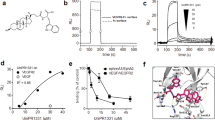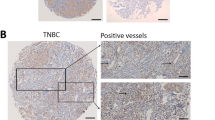Abstract
Angiogenesis is among the most important mechanisms that helps cancer cells to survive, grow and undergo metastasis. Therefore, inhibiting angiogenesis will suppress tumor growth. Vascular endothelial growth factor (VEGF) and its receptor (VEGFR) are believed to be important players of angiogenesis. The goal of this study was to evaluate the success of a novel nanobody against VEGFR2 in tethering its target inside the endoplasmic reticulum and preventing its transport to the cell membrane. Nanobody sequence was cloned in a mammalian vector in fusion with green fluorescent protein and a KDEL retention signal. After transfection of 293KDR cells with this expression vector, surface localization of VEGFR2 was monitored by flow cytometry. This study demonstrates that our intrananobody is effective in targeting VEGFR2 receptor, and therefore, it is a powerful tool to downregulate a surface-exposed target protein, and in this capacity, it has potential to be used as a therapeutic protein to inhibit growth of tumors.
This is a preview of subscription content, access via your institution
Access options
Subscribe to this journal
Receive 12 print issues and online access
$259.00 per year
only $21.58 per issue
Buy this article
- Purchase on Springer Link
- Instant access to full article PDF
Prices may be subject to local taxes which are calculated during checkout




Similar content being viewed by others
References
Folkman J Angiogenesis and angiogenesis inhibition: an overview. Regulation of Angiogenesis. Springer: Birkhäuser Basel, 1997, pp 1–8.
Robinson CJ, Stringer SE . The splice variants of vascular endothelial growth factor (VEGF) and their receptors. J Cell Sci 2001; 114: 853–865.
Folkman J, Hanahan D . Switch to the angiogenic phenotype during tumorigenesis. Princess Takamatsu Symp 1990; 22: 339–347.
Folkman J . What is the evidence that tumors are angiogenesis dependent? J Natl Cancer Inst 1990; 82: 4–7.
Eichmann A, Simons M . VEGF signaling inside vascular endothelial cells and beyond. Curr Opin Cell Biol 2012; 24: 188–193.
Carmeliet P, Jain RK . Molecular mechanisms and clinical applications of angiogenesis. Nature 2011; 473: 298–307.
Sina K, Sonia T, Xiujuan L, Laura G, Lena C-W . Signal transduction by vascular endothelial growth factor receptors. Biochem J 2011; 437: 169–183.
Shibuya M, Yamaguchi S, Yamane A, Ikeda T, Tojo A, Matsushime H et al. Nucleotide sequence and expression of a novel human receptor-type tyrosine kinase gene (flt) closely related to the fms family. Oncogene 1990; 5: 519–524.
Terman BI, Carrion M, Kovacs E, Rasmussen B, Eddy R, Shows T . Identification of a new endothelial cell growth factor receptor tyrosine kinase. Oncogene 1991; 6: 1677–1683.
Izzedine H . Anti-VEGF cancer therapy in nephrology practice. Int J Nephrol 2014; 2014: 143426.
Neufeld G, Cohen T, Gengrinovitch S, Poltorak Z . Vascular endothelial growth factor (VEGF) and its receptors. FASEB J 1999; 13: 9–22.
Kazemi-Lomedasht F, Behdani M, Pooshang Bagheri K, Habibi Anbouhi M, Abolhassani M, Khanahmad H et al. Expression and purification of functional human vascular endothelial growth factor-a121; the most important angiogenesis factor. Adv Pharm Bull 2014; 4: 323–328.
Behdani M, Zeinali S, Khanahmad H, Karimipour M, Asadzadeh N, Azadmanesh K et al. Generation and characterization of a functional Nanobody against the vascular endothelial growth factor receptor-2; angiogenesis cell receptor. Mol Immunol 2012; 50: 35–41.
Ferrara N, Hillan KJ, Novotny W . Bevacizumab (Avastin), a humanized anti-VEGF monoclonal antibody for cancer therapy. Biochem Biophys Res Commun 2005; 333: 328–335.
Sullivan LA, Brekken RA . The VEGF family in cancer and antibody-based strategies for their inhibition. MAbs 2010; 2: 165–175.
Wheeler YY, Kute TE, Willingham MC, Chen S-Y, Sane DC . Intrabody-based strategies for inhibition of vascular endothelial growth factor receptor-2: effects on apoptosis, cell growth, and angiogenesis. FASEB J 2003; 17: 1733–1735.
Li T, Wang G-d, Tan Y-z, Wang H-j . Inhibition of lymphangiogenesis of endothelial progenitor cells with VEGFR-3 siRNA delivered with PEI-alginate nanoparticles. Int J Biol Sci 2014; 10: 160.
Wang F, Li H-M, Wang H-P, Ma J-L, Chen X-F, Wei F et al. siRNA-mediated knockdown of VEGF-A, VEGF-C and VEGFR-3 suppresses the growth and metastasis of mouse bladder carcinoma in vivo. Exp Ther Med 2010; 1: 899–904.
Wang F-q Barfield E, Dutta S, Pua T, Fishman DA . VEGFR-2 silencing by small interference RNA (siRNA) suppresses LPA-induced epithelial ovarian cancer (EOC) invasion. Gynecol Oncol 2009; 115: 414–423.
Cunningham SA, Tran TM, Arrate MP, Brock TA . Characterization of vascular endothelial cell growth factor interactions with the kinase insert domain-containing receptor tyrosine kinase. A real time kinetic study. J Biol Chem 1999; 274: 18421–18427.
Marasco WA . Intrabodies: turning the humoral immune system outside in for intracellular immunization. Gene Ther 1997; 4: 11–15.
der Maur AA, Escher D, Barberis A . Antigen-independent selection of stable intracellular single-chain antibodies. FEBS Lett 2001; 508: 407–412.
Carlson JR . A new means of inducibly inactivating a cellular protein. Mol Cell Biol 1988; 8: 2638–2646.
Lecerf J-M, Shirley TL, Zhu Q, Kazantsev A, Amersdorfer P, Housman DE et al. Human single-chain Fv intrabodies counteract in situ huntingtin aggregation in cellular models of Huntington's disease. Proc Natl Acad Sci 2001; 98: 4764–4769.
Yu F, Wang Y, Xiao Y, He Y, Luo C, Duan D et al. RP215 single chain fragment variable and single domain recombinant antibodies induce cell cycle arrest at G0/G1 phase in breast cancer. Mol Immunol 2014; 59: 100–109.
Popkov M, Jendreyko N, McGavern DB, Rader C, Barbas CF . Targeting tumor angiogenesis with adenovirus-delivered anti-Tie-2 intrabody. Cancer Res 2005; 65: 972–981.
Nejatollahi F, Abdi S, Asgharpour M . Antiproliferative and apoptotic effects of a specific antiprostate stem cell single chain antibody on human prostate cancer cells. J Oncol 2013; 2013: 839831.
Sagawa M, Shimizu T, Fukushima N, Kinoshita Y, Ohizumi I, Uno S et al. A new disulfide-linked dimer of a single-chain antibody fragment against human CD47 induces apoptosis in lymphoid malignant cells via the hypoxia inducible factor-1α pathway. Cancer Sci 2011; 102: 1208–1215.
Intasai N, Tragoolpua K, Pingmuang P, Khunkaewla P, Moonsom S, Kasinrerk W et al. Potent inhibition of OKT3-induced T cell proliferation and suppression of CD147 cell surface expression in HeLa cells by scFv-M6-1B9. Immunobiology 2009; 214: 410–421.
Zhu X, Yang N, Cai J, Yang G, Liang S, Ren D . The intrabody targeting of hTERT attenuates the immortality of cancer cells. Cell Mol Biol Lett 2010; 15: 32–45.
Zehner M Sec61 Mediates Antigen Translocation into the Cytosol for Cross-Presentation. Universitäts-und Landesbibliothek Bonn: 2015.
Lippincott-Schwartz J, Bonifacino JS, Yuan LC, Klausner RD . Degradation from the endoplasmic reticulum: disposing of newly synthesized proteins. Cell 1988; 54: 209–220.
Fra A, Fagioli C, Finazzi D, Sitia R, Alberini C . Quality control of ER synthesized proteins: an exposed thiol group as a three-way switch mediating assembly, retention and degradation. EMBO J 1993; 12: 4755.
Munro S, Pelham HR . A C-terminal signal prevents secretion of luminal ER proteins. Cell 1987; 48: 899–907.
Bu G, Rennke S, Geuze HJ . ERD2 proteins mediate ER retention of the HNEL signal of LRP's receptor-associated protein (RAP). J Cell Sci 1997; 110: 65–73.
Behdani M, Zeinali S, Karimipour M, Khanahmad H, Asadzadeh N, Azadmanesh K et al. Expression, purification, and characterization of a diabody against the most important angiogenesis cell receptor: vascular endothelial growth factor receptor 2. Adv Biomed Res 2012; 1: 34.
Gerber H-P, Ferrara N . The role of VEGF in normal and neoplastic hematopoiesis. J Mol Med 2003; 81: 20–31.
Marasco WA, Haseltine WA, Chen S . Design, intracellular expression, and activity of a human anti-human immunodeficiency virus type 1 gp120 single-chain antibody. Proc Natl Acad Sci 1993; 90: 7889–7893.
Mhashilkar AM, Lavecchio J, Eberhardt B, Porter-Brooks J, Boisot S, Dove JH et al. Inhibition of human immunodeficiency virus type 1 replication in vitro in acutely and persistently infected human CD4+ mononuclear cells expressing murine and humanized anti-human immunodeficiency virus type 1 Tat single-chain variable fragment intrabodies. Hum Gene Ther 1999; 10: 1453–1467.
Marasco WA, LaVecchio J, Winkler A . Human anti-HIV-1 tat sFv intrabodies for gene therapy of advanced HIV-1-infection and AIDS. J Immunol Methods 1999; 231: 223–238.
Duan L, Bagasra O, Laughlin MA, Oakes JW, Pomerantz RJ . Potent inhibition of human immunodeficiency virus type 1 replication by an intracellular anti-Rev single-chain antibody. Proc Natl Acad Sci 1994; 91: 5075–5079.
Wu Y, Duan L, Zhu M, Hu B, Kubota S, Bagasra O et al. Binding of intracellular anti-Rev single chain variable fragments to different epitopes of human immunodeficiency virus type 1 rev: variations in viral inhibition. J Virol 1996; 70: 3290–3297.
Millauer B, Shawver LK, Plate KH, Risaui W, Ullrich A . Glioblastoma growth inhibited in vivo by a dominant-negative Flk-1 mutant. Nature 1994; 367: 576–579.
Alvarez RD, Barnes MN, Gomez-Navarro J, Wang M, Strong TV, Arafat W et al. A cancer gene therapy approach utilizing an anti-erbB-2 single-chain antibody-encoding adenovirus (AD21): a phase I trial. Clin Cancer Res 2000; 6: 3081–3087.
Southwell AL, Ko J, Patterson PH . Intrabody gene therapy ameliorates motor, cognitive, and neuropathological symptoms in multiple mouse models of Huntington's disease. J Neurosci 2009; 29: 13589–13602.
Acknowledgements
We thank the cellular and molecular interaction department-Vrije Universiteit Brussel, Brussels, Belgium. This project was financially supported by the Pasteur Institute of Iran.
Author information
Authors and Affiliations
Corresponding author
Ethics declarations
Competing interests
The authors declare no conflict of interest.
Rights and permissions
About this article
Cite this article
Alirahimi, E., Ashkiyan, A., Kazemi-Lomedasht, F. et al. Intrabody targeting vascular endothelial growth factor receptor-2 mediates downregulation of surface localization. Cancer Gene Ther 24, 33–37 (2017). https://doi.org/10.1038/cgt.2016.76
Received:
Revised:
Accepted:
Published:
Issue Date:
DOI: https://doi.org/10.1038/cgt.2016.76
This article is cited by
-
Targeted therapy of angiogenesis using anti-VEGFR2 and anti-NRP-1 nanobodies
Cancer Chemotherapy and Pharmacology (2022)
-
A Novel Immunotoxin Targeting Epithelial Cell Adhesion Molecule Using Single Domain Antibody Fused to Diphtheria Toxin
Molecular Biotechnology (2022)
-
Antiangiogenic effects of oridonin
BMC Complementary and Alternative Medicine (2017)



